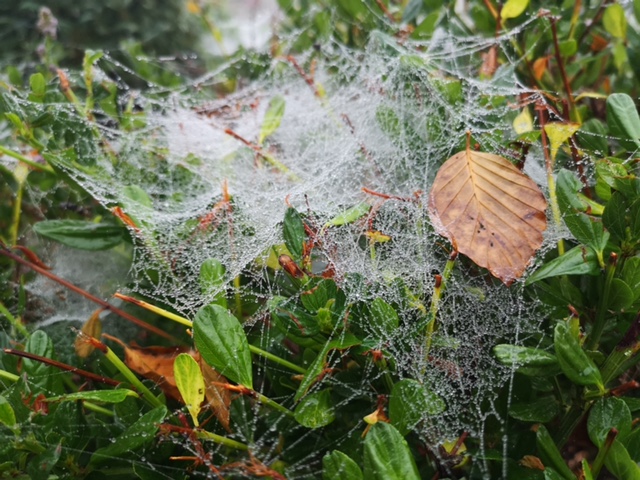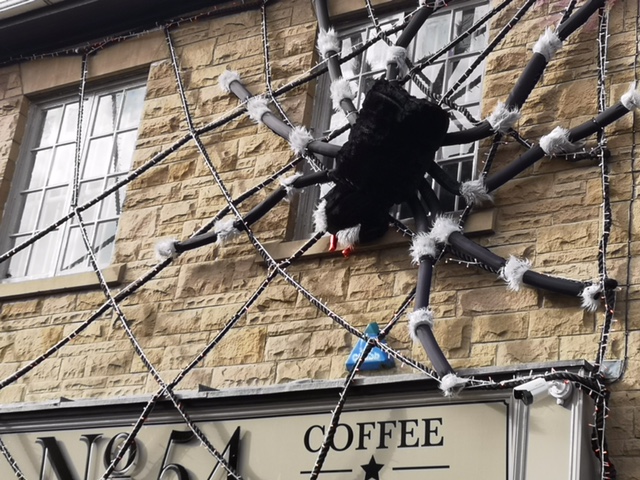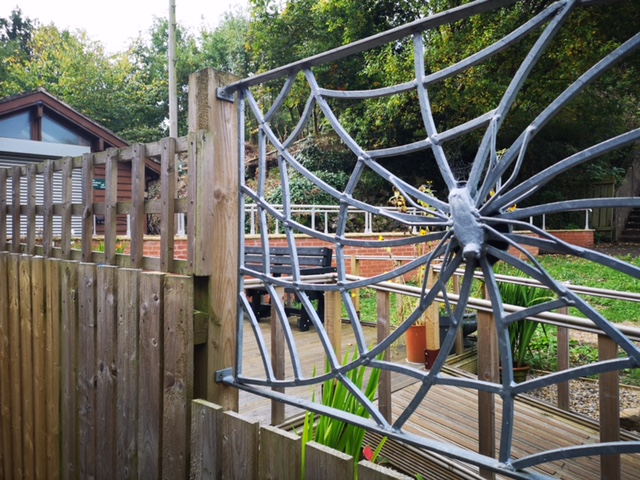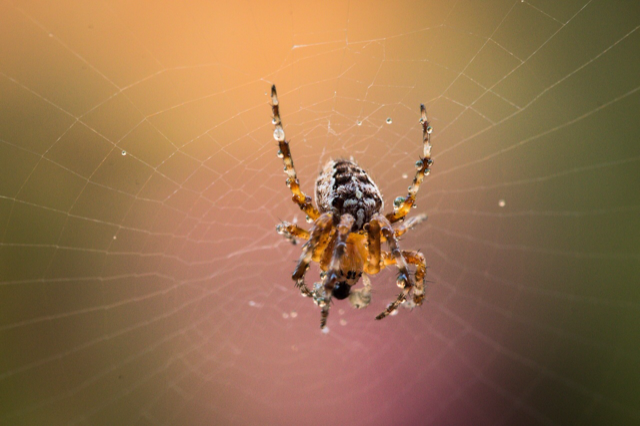
Debbie is a freelance writer and lecturer in Teacher Education. She has contributed creative fiction and non-fiction to anthologies, has written for BBC Countryfile and is a regular contributor to Leeds Living website (https://leedsliving.co.uk/author/debbie-rolls/). She is in process of writing a children’s book presenting world history through the eyes of a spider.
She can be contacted by emailing spiderfriendlyschools@gmail.com
Late October frustrates me.

On the one hand I spot some beautiful spiders. Male spiders are out and about looking for mates. The vegetation in my garden is dying off, making spiders more visible. Misty mornings dissolve away to leave sparkling webs amongst autumn foliage. I am packing away garden furniture into the garage, disturbing spiders in the process, marvelling at their intricate engineering.

On the other hand, I am confronted by images of ‘scary spiders.’ Shops and houses are bedecked with sustainably suspect plastic spiders and webs. The disposable consumer culture, which has always been present around Christmas, seems to have spread to Halloween with force over recent years. I have seen tinsel spiders, spiders with flashing lights and hundreds of different plastic versions.
Not that I am completely against associating spiders with Halloween. In traditional English folklore seeing a spider on All-Hallows Eve was a good omen. Spiders were traditionally seen as the embodiment of our ancestors. To see a spider on Halloween, a word derived from a Scottish contraction of All-Hallows Eve, was a sign that your ancestors were watching over and caring for you. There is a rich cultural tradition of positive stories towards spiders including Native American origin stories, African and Caribbean Anansi stories and Charlotte’s Webb. I worry that this tradition is being overshadowed and replaced by association of spiders with fear.
British gothic and Hollywood horror have combined to present a very different media image of the humble spider. It is an image that children are growing up with and must be affecting their perceptions. Whilst arachnophobia is clearly a definable condition it is noticeable that it seems to be more common in Britain and the Unites States than in Asia and Africa. If your most frequently viewed image of a spider is as a Halloween decoration then the word spider may become intrinsically linked with the word scary.
As someone who works in Teacher Education, I became particularly concerned about attitudes to Spiders in 2018. A total of twelve schools closed in autumn 2018 as a result of finding false widow spiders on their sites. These spiders rarely bite humans. If they do, then the impact is similar to be being stung by a wasp. It would be a very sad day if we were to remove flowering plants from schools, in case, they attracted wasps or bees that might sting children. Even in Australia, where some spiders are venomous, there have been no recent deaths from spider bites
You would think that given the impact of lost education caused by Covid that schools would not be closing their doors unless there was a major threat to staff and students. Yet, unbelievably, two schools in Northampton sent children home this September because of spiders. One of the schools had also done so in 2018. False widow spiders are found across Europe and have been identified across Britain, including Scotland, but only in England has their presence led to school closures.
In 2019 I sent a Freedom of Information request to the schools that closed in an attempt to understand their actions. Only one of the schools claimed that anyone had been bitten and the person bitten was described as a ‘visitor’ making verification difficult. Some schools absolved themselves of responsibility, saying it was the decision of the company running the facilities. Others claimed it was on advice from Public Health England (PHE), although the PHE school briefing document advises against closure. No one sent me a risk assessment outlining how the decision had been arrived at.
My concern is not just around the ill judgement of closing schools but the lack of response these actions received. Environmental organisations such as Bug Life condemned the 2018 closures and Patrick Barkham, in the Guardian, described it as a ‘human tragedy.’ However, there was very little response from parents’ groups, teachers’ organisations, students or politicians. Media reports often played up the ‘spider threat’ rather than the fact children were missing education.
In my role as a lecturer in Teacher Education I decided to survey our trainee teachers to assess their attitudes to spiders. My personal research shows common antipathy towards spiders, a lack of knowledge of the ecological role of spiders and a reluctance to teach about spiders. A fear of spiders was shown to interfere with everyday tasks, such as using a bath, as well as hindering interactions in the classroom. A quarter of the students I surveyed either would ask if they could be excused from teaching about spiders or what teach the topic reluctantly. Interestingly the students who had been born in Asia or Africa did not seem to share this reluctance. For them, spiders were creatures that you had no alternative but to live alongside. There is a danger that we perceive our homes in England as hermetically sealed units where the non-human must be halted at the door.

One common misconception I found among the students was the belief that you find spiders in your home, and particularly your bath, because they climb up the drainpipe. Incy Wincy has a lot to answer for. Once I explained that spiders need to drink, so find their way into sinks and baths, but then find it difficult to get out again, perceptions were changed. The invader became victim. I pointed out that hotels often leave floor mats or towels hanging over the side of baths to give spiders an escape route. Spiders are living in every building in the country but they hide away in dark corners so they are not regularly seen.
There is some indication that humans have an innate fear of spiders, although not as strong as that towards snakes. However, it is a fear that can be overcome or enhanced depending upon social conditioning. The London Zoological Society’s ‘Friendly Spider Programme’ indicates that even severe arachnophobia can be overcome. One Halloween activity I really enjoyed a few years ago was a spider workshop at RSPB Bempton Cliffs. We learnt about spiders, went on a spider hunt and looked at spiders under microscopes. Using electronic toothbrushes to entice spiders out of their hiding places was great fun. Under a microscope, spiders are revealed as intricate creatures that often sparkle, truly beautiful. Interestingly the warden leading the workshop had attended the London Zoo course in order to overcome acute arachnophobia and now loves spiders.
I am not alone in my concern about children’s attitudes to spiders. Alison Steadman, a keen naturalist as well as actor, wrote her children’s book ‘Spider!’ in response to a conversation with a child who told her he disliked spiders. When promoting the book on the Marie Curie website (she is an ambassador for the charity) she writes:
‘So many adults are scared of spiders and pass this on to children. I wrote this book to change that. They are fascinating creatures. Learn to love them’.
Emma Read has written the ‘Mighty Milton’ books for older readers. Her hero is a false widow spider. In her writing she touches upon the power of the internet for good and bad, the possible vested interests of pest control companies and arachnophobia. Emma’s background is in biology but when she started researching for the Milton character, she was a declared arachnophobe. Her website now gives others advice on how to overcome arachnophobia.
Other children’s books do not present positive images of spiders. Even natural history books for children featuring spiders are often entitled ‘Creepy Crawlies’, subliminally associating to the creepy, scary language of Halloween. I am a fan of the writing of Francesca Simon and the illustration of Tony Ross but I have to question their decision to name the nightmare school in their book ‘Spider School.’
I have started running sessions for trainee teachers on why we need to make schools spider friendly and this year addressed the TEAN (Teacher Education Advancement Network) conference on this subject. I had hoped to start going into schools to talk to children but Covid interfered with these plans. I am glad to say that some of the trainee teachers I have talked to have become more positive about spiders.
For years various projects have taken spiders into schools. These have often been tarantulas and have been presented alongside snakes, giant snails and other creatures which are seen as repugnant. Whilst I agree that no creature should be seen as horrible or scary a tarantula is not really representative of most spiders.
A better introduction to spiders is a jumping spider. Although small, many people do keep these as pets and interact with them. They can be very cute. One tool I have found useful when trying to win over the hearts and minds of adults and children are videos of Lucas, the brainchild of animator Joshua Slice. Lucas is definitely a character that is lovable rather than scary.
The image of spiders in our society matters not just because of the impact it has on human society, or spiders, but there are wider implications for our environment. We are currently faced with species extinction due to the overuse of pesticides. Spiders have an important role to play in developing sustainable agriculture. Well-kept hedges full of spiders act as effective pest control.
This Halloween please do not use spider motifs to decorate your house, classroom or office. Instead think about how to celebrate spiders. Buy a child a book about spiders, watch a Lucas video or encourage your local primary school to take a spider positive approach. This may mean addressing your own arachnophobia. I hope you will grow to love spiders, or at least help the younger generation grow up with more positive attitudes.

What a great blog post. I work for nature conservation charities and every year we hear the false widow scaremongering. I used to be scared of spiders but lost my fear via photography. I wonder whether one way for children to lose their fear would be to take photos of spiders? You can buy a camera (some pretty cheap point and shoot have amazing macro capabilities now) take it into schools for children to use, then show the photos on a screen? I fell in love with jumping spiders when I saw them close up. Good luck!
Hi Jane
yes research suggests that seeing photos of spiders is a great way to overcome fear. Lots of classrooms have ipads and you can get a reasonable photo just using these although a macro lens attached to a phone or tablet can also make it even better. Lots of schools also have cameras.
Debbie
Superb blog Debbi! I suffer from serious arachnophobia as do both my sisters. Our dad was clearly so when we were very young and I can’t help feeling that’s the main reason we are, it was mostly picked up from an adult. There’s something alarming about the way spiders can scurry at top speed, and I have no doubt there’s a degree of instinctive reaction against them, but as you point out it’s mostly cultural and family influences that are responsible for these largely irrational fears. It seems way over the top to regard arachnophobia as a handicap, but it’s not far off it – many of us take into consideration how likely we are to run into biggish spiders at various holiday destinations. There are a lot bigger problems than being scared of spiders, but just being scared is hellish. All power to your elbow!
I also have to concur with you about Halloween now becoming an extension of the market for disposable consumer crap we get at Xmas. There’s also a period in early summer when supermarkets stock cheap tents, foldable seats, sleeping bags and mats. It’s not too difficult to see where this rather new and clearly large market for cheap camping equipment has come from when you start seeing pictures of the aftermath of festivals like Glastonbury, utterly strewn with the same abandoned tents, sleeping bags, chairs – too much hassle to maybe clear a bit of mud off and pack away. I remember joining a recycling project in 1989 and the talk was of how one day we’d have to put disposable razors in museums as that type of waste was on its way out. Now thirty plus years later our supermarkets are falling over themselves to sell us disposable tents and other camping equipment. We need a serious upbeat in the quantity and quality of education for both spiders and other wildlife and reduce, reuse, recycle, two integral, interlinked elements of conservation.
Following on from my comments to Jane about looking at pictures of spiders I wonder if you have tried this. I belong to a couple of facebook spider pages (UK Spiders and Jumping Spiders UK) and have noticed that some arachnophobes are joining these groups to help them overcome their fear.
Debbie, this is a great blog but a ‘bug’ is stopping me use the like button.
I have wasted many hours in the garden watching spiders when I should be working. Natures own insecticide.
The bug would not let me like your comment either.
They can be even more distracting when you are working in a shed or garage.
I agree with nearly everything you say, Paul, but the time you spent watching spiders in the garden wasn’t wasted!
Love spiders, always have, though one of my daughters was phobic about them when she was a child. It was very much the same kind of instinctive reaction that many have towards snakes so I’ve always suspected something deep in the subconscious. Perhaps our distant ancestors were more acquainted with dangerous varieties? Like Paul, the button is not working for me but thanks for a very useful blog.
Lovely blog post.
I brought my 2 up to not be scared of spiders. They were brought up to handle them (gently) and evict them kindly. They are doing the same with theirs. One of the grandchildren worships the ground Steve Backshall walks on. The other half’s attitude to spiders is more long-standing/engrained, but I’ve managed to soften that as well, along with the attitude to wasps. Although that has a more valid, deep seated reason, having inadvertently disturbed a wasp nest in a very major manner when young which resulted in many wasp stings.
I’ve about a dozen or so orb web type currently around the margins of the kitchen window (on the outside, I’ve watched them hatch and grow from spiderlings), cellar spiders are regulars indoors. And house spiders are evicted at this time of year to a shed or other sheltered location.
For every person like Debbie, Alison Steadman or Emma Read who is trying to foster a more enlightened attitude towards spiders there is a tabloid editor who just can’t resist pushing out scare stories about them.
Stories about invasions of ‘deadly’ spiders are a staple of the tabloid press and even when there is an expert’s comment buried deep within the story to the effect that spiders are actually harmless to humans (certainly in the UK) and even beneficial, these are lost beneath the blizzard of scare words such as ‘invasion’, ‘deadly’, ‘venom’, ‘fangs’ and such like. See for example https://www.examinerlive.co.uk/news/uk-world-news/14-dangerous-uk-spiders-invading-21501454 for an example of the kind of scare-mongering and false rubbish that is disseminated.
I suppose it is not exactly a shocking new revelation that large parts of the media are less than completely committed to truth and accuracy but it is deeply dispiriting. As far as spiders are concerned it helps to ensure that much of the British population will continue to harbour totally unjustified negative feelings towards them.
I cringe when I see spiders in the news because it’s nearly always bad press. Lovely to see something promoting them. Thanks Debbie!